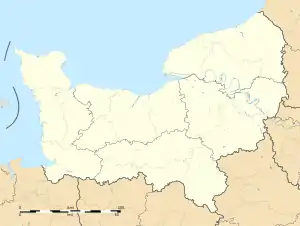Morgny-la-Pommeraye | |
|---|---|
 The church in Morgny-la-Pommeraye | |
.svg.png.webp) Coat of arms | |
Location of Morgny-la-Pommeraye | |
 Morgny-la-Pommeraye  Morgny-la-Pommeraye | |
| Coordinates: 49°30′41″N 1°15′21″E / 49.5114°N 1.2558°E | |
| Country | France |
| Region | Normandy |
| Department | Seine-Maritime |
| Arrondissement | Rouen |
| Canton | Le Mesnil-Esnard |
| Government | |
| • Mayor (2020–2026) | Pascal Sagot[1] |
| Area 1 | 6.48 km2 (2.50 sq mi) |
| Population | 1,071 |
| • Density | 170/km2 (430/sq mi) |
| Time zone | UTC+01:00 (CET) |
| • Summer (DST) | UTC+02:00 (CEST) |
| INSEE/Postal code | 76453 /76750 |
| Elevation | 120–168 m (394–551 ft) (avg. 164 m or 538 ft) |
| 1 French Land Register data, which excludes lakes, ponds, glaciers > 1 km2 (0.386 sq mi or 247 acres) and river estuaries. | |
Morgny-la-Pommeraye (French pronunciation: [mɔʁɲi la pɔmʁɛ]) is a commune in the Seine-Maritime department in the Normandy region in north-western France.
Geography
A farming village situated some 11 miles (18 km) northeast of Rouen at the junction of the D 12, D 90 and the D 15 roads. Morgny station has rail connections to Rouen, Lille and Amiens.
Heraldry
.svg.png.webp) Arms of Morgny-la-Pommeraye |
The arms of Morgny-la-Pommeraye are blazoned : Azure, a double-headed eagle (??with wings lowered??), and on a chief Or, in pale a mullet of 5 and a crescent gules, between a swan passant and a broom plant vert.
|
Population
| Year | Pop. | ±% p.a. |
|---|---|---|
| 1968 | 309 | — |
| 1975 | 474 | +6.30% |
| 1982 | 590 | +3.18% |
| 1990 | 793 | +3.77% |
| 1999 | 892 | +1.32% |
| 2007 | 1,023 | +1.73% |
| 2012 | 1,003 | −0.39% |
| 2017 | 1,023 | +0.40% |
| Source: INSEE[3] | ||
Places of interest
- The church of Notre-Dame, dating from the seventeenth century.
- The church of St.Madeleine, dating from the seventeenth century.
- The Château de Mondétour.
- A sixteenth century manorhouse.
See also
References
- ↑ "Répertoire national des élus: les maires" (in French). data.gouv.fr, Plateforme ouverte des données publiques françaises. 13 September 2022.
- ↑ "Populations légales 2021". The National Institute of Statistics and Economic Studies. 28 December 2023.
- ↑ Population en historique depuis 1968, INSEE
Wikimedia Commons has media related to Morgny-la-Pommeraye.
This article is issued from Wikipedia. The text is licensed under Creative Commons - Attribution - Sharealike. Additional terms may apply for the media files.